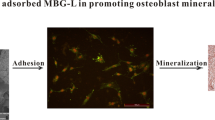Abstract
Hydroxyapatite bone granules with a macroporous structure were produced and then adsorbed with basic fibroblast growth factor (FGF2). The in vitro scaffolding role of the granules in cell population and osteogenic differentiation was investigated. The FGF2-adsorbed porous granules allowed the MC3T3-E1 cells to adhere well and then proliferate actively. While the cell growth level on the FGF2-treated granules was observed to be similar to that on the untreated granules, the expression of genes associated with bone, including collagen type I, alkaline phosphatase, and osteocalcin was significantly up-regulated by the FGF2 treatment, particularly at the early stage. Moreover, the production of alkaline phosphatase with prolonged culturing was greatly enhanced on the FGF2-adsorbed granules. Taken together, the FGF2 treatment of the hydroxyapatite granules was effective in the osteogenic development and the FGF2-adsorbed bone granules may be useful in bone regeneration area.






Similar content being viewed by others
References
Bauer TW, Muschler GF. Bone graft materials: an overview of the basic science. Clin Orthop Relat Res. 2000;371:10–27.
Hench LL, Polak JM. Third-generation biomedical materials. Science. 2002;295:1014–7.
Al Ruhaimi KA. Bone graft substitutes: a comparative qualitative histologic review of current osteoconductive grafting materials. Int J Oral Maxillofac Implants. 2001;16:105–14.
Damien CJ, Parsons JR. Bone graft and bone graft substitutes: a review of current technology and applications. J Appl Biomater. 1991;2:187–208.
Behairy Y, Jasty M. Bone grafts and bone substitutes in hip and knee surgery. Orthop Clin N Am. 1999;30:661–71.
Jansen JA, Vehof JW, et al. Growth factor-loaded scaffolds for bone engineering. J Control Release. 2005;101:127–36.
Gupta MC, Maitra S. Bone grafts and bone morphogenetic proteins in spine fusion. Cell Tissue Bank. 2002;3:255–67.
Mackie EJ, Trechsel U. Stimulation of bone formation in vivo by transforming growth factor-beta: remodeling of woven bone and lack of inhibition by indomethacin. Bone. 1990;11:295–300.
Logan A, Baird A. Fibroblast growth factors. Growth Factor Cytokine Health Dis. 1996;1:147–78.
Thompson JA, et al. Site-directed neovessel formation in vivo. Science. 1988;241:1349–52.
Kanczler JM, Oreffo ROC. Osteogenesis and angiogenesis: the potential for engineering bone. Eur Cells Mater. 2008;15:100–14.
Wang JS, Aspenberg P. Basic fibroblast growth factor promotes bone ingrowth in porous hydroxyapatite. Clin Orthop Relat Res. 1996;333:252–60.
Jang JH, Ku Y, et al. Enhanced fibronectin-mediated cell adhesion of human osteoblast by fibroblast growth factor, FGF-2. Biotechnol Lett. 2002;24:1659–63.
Cavallaro U, Tenan M, Castelli V, Perilli A, Maggiano N, Van Meir EG, et al. Response of bovine endothelial cells to FGF-2 and VEGF is dependent on their site of origin: relevance to the regulation of angiogenesis. J Cell Biochem. 2001;82:619–33.
Lee EJ, Yoon BH, et al. Highly porous hydroxyapatite bioceramics with interconnected pore channels using camphene-based freeze casting. Mater Lett. 2007;61:2270–3.
Muschler GF, Lane JM. Orthopedic surgery. In: Habal MB, Reddi AH, editors. Bone grafts and bone substitutes. Philadelphia: Saunders; 1992. p. 375–407.
Mistry AS, Mikos AG. Tissue engineering strategies for bone regeneration. Adv Biochem Eng Biotechnol. 2005;94:992–1006.
Rouwkema J, Rivron NC, van Blitterswijk CA. Vascularization in tissue engineering. Trends Biotechnol. 2008;26:434–41.
Hollister SJ. Porous scaffold design for tissue engineering. Nat Mater 2005;4:518–24.
Meyers GA, Orlow SJ, et al. Fibroblast growth factor receptor 3 (FGFR3) transmembrane mutation in Crouzon syndrome with acanthosis nigricans. Nat Gene. 1995;11:462–4.
Canalis E, Centrella M, McCarthy T. Effects of basic fibroblast growth factor on bone formation in vitro. J Clin Investig. 1988;8:1572–7.
Hong KS, Jeong IS, et al. Bone regeneration by bioactive hybrid membrane containing FGF-2 within rat calvarium. J Biomed Mater Res Part A. 2010 (in progress).
Nakasa T, Ishida O, et al. Prefabrication of vascularized bone graft using the combination of FGF-2 and vascular bundle implantation into a novel interconnected porous calcium hydroxyapatite ceramic. J Biomed Mater Res A. 2005;75:350–5.
Acknowledgment
The present research was conducted by the research fund of Dankook University in 2008.
Author information
Authors and Affiliations
Corresponding author
Additional information
Ishik Jeong and Hye-Sun Yu are contributed equally to this work.
Rights and permissions
About this article
Cite this article
Jeong, I., Yu, HS., Kim, MK. et al. FGF2-adsorbed macroporous hydroxyapatite bone granules stimulate in vitro osteoblastic gene expression and differentiation. J Mater Sci: Mater Med 21, 1335–1342 (2010). https://doi.org/10.1007/s10856-009-3971-2
Received:
Accepted:
Published:
Issue Date:
DOI: https://doi.org/10.1007/s10856-009-3971-2




